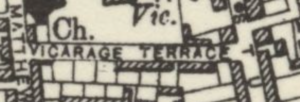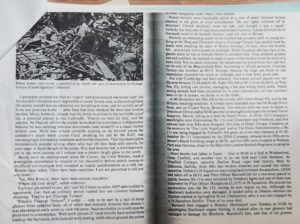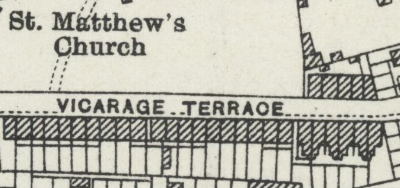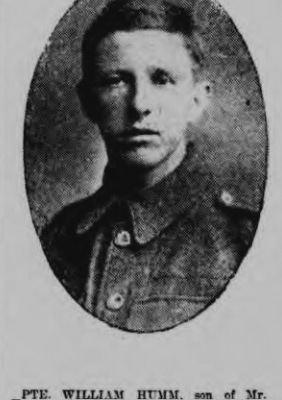Search by topic
- archaeology
- Building of Local Interest
- charity
- church
- crime
- dressmaker
- fire
- Great Eastern Railway
- Listed building
- Mapping Relief
- medieval
- oral history
- poverty
- Public House
- Rattee & Kett
- Religious House
- Roman
- scholar
- school
- Then and Now
- tudor
- women
- work
- world war one
- world war two
Search by text
 Vicarage Terrace
Vicarage TerraceVicarage Terrace
History of Vicarage Terrace
1913
NORTH SIDE
Rev. F Hawtrey, St Matthew’s Vicarage
(22) Miss Gates
Mrs Wisbey
(24) George Lofts, labourer
(26) David Dear, labourer
(28) George Miles, labourer
(30) Robert Asplen, labourer
HERE IS ST MATTHEWS STREET [Incorrectly labelled STURTON]
SOUTH SIDE
(1) Arthur Henry Lowlings, labourer
(2) William Langley, gardener
(3) Thomas Humm, plasterer
(4) Charles Gillingham, labourer
(5) James Batham, labourer
(6) Sidney S Palmer, printer
(7) Charles Unwin, mill hand
(8) Henry Savage, college servant
(9) John Chapman
(10) John Asbey, coalheaver
(11) Elijah Tarrant, painter
(12) Ernest Cornwell, college servant
(13) William Gates, hotel porter
(14) Mrs Green
(15) Charles Aldridge, labourer
(16) Alfred Watson, labourer
(17) William Loynes, dealer
(18) Mrs Wyer
(19) Thomas Overhill, bootmaker
(21) Andrew Thomas n Prevett, bookbinder
(23) Frederick Loynes
(25) Mrs Gooch, greengrocer
(27) A Peck
(29) Frederick Graves
(31) John Robert Bagstaff, labourer
1939
(1)
Cyril Leonard Dear, b 1916, builder’s labourer
(2)
William Langley, b 1895, college butler
Lily, b 1893
William, b 1921, bricklayer’s apprentice
(3)
Charles Frederick Clark, b 1896, fruit salesman
Daisy, b 1898
Peggy, b 1923, factory hand
Barbara P, b 1925
Gladys, b 1927
Hetty Rosen, b 1930
(4)
Alfred Watts, b 1898, journeying coalman
Mabel, b 1891
(5)
Thomas A Beresford, b 1907, river foreman
Alice V, b 1908
Michael T, b 1938
?
?
(6)
Sidney S Palmer, b 1886, printer’s labourer
Emma, b 1888
(7)
Charles T Unwin, b 1886, college servant
Sophia K, b 1883
Harold B, b 1910, brush factory machinist
Arthur, b 1915, van salesman
Olive, b 1919, typist
(8)
Leonard S Palmer, b 1909, carpenter and joiner
Doris, b 1906
Molly, b 1930
Leonard, b 1935
Kite Marks 2023: … five-year-old Lenny Palmer, one of the fatalities of the bombing who was one of my mother’s playmates in 1940. Lenny lived at 8 Vicarage Terrace with his parents Leonard and Doris and younger sister Molly (all casualties). My mother remembers the Palmers owning or managing a sweet shop which, as she recalls, was situated at the top of Vicarage Terrace where it meets St Matthew’s Street, on the right-hand side of the road opposite the wall of St Matthew’s Church.
(9)
Edith Hutchins, b 1893, domestic cleaner
(10)
Eric Kingston, b 1908, builders labourer (ARP service full time)
Rosina J, b 1915
?
?
?
(11)
Alfred Hinson, b 1891, tailor trouser maker
May F, b 1894
Maud Dorothy, b 1913, radio coil winder
Stanley A, b 1915, screw machine tool fitter
(12)
May Langford, b 1890
Edward C, b 1891
Reginald, b 1916
?
?
Elizabeth Quarterman, b 1860
?
(13)
Clara Blinco, b 1878
James Hobbs, b 1878
(14)
Martha Hatchman, b 1890
Joyce, b 1922, sewing machinist knitting factory
(15)
John Northfield, b 1868, general labourer
Elizabeth A, b 1874
?
?
(16)
Alfred F Watson, b 1882, public works labourer
Annie, b 1885
Sydney A, b 1908
?
?
?
(17)
Minnie L Darling, b 1984
?
(18)
Arthur G Fordham, b 1901, journeyman baker
Ellen R, b 1908
?
Derek, b 1936
?
?
(19)
Arthur Fordham, b 1891, general labourer
Lily, b 1905
Ruby, b 1912
(21)
Susan Prevett, b 1854, old age pensioner
Susan, b 1880, incapacitated
George Fenton, b 1892, iron moulder
Gertrude Fenton, b 1893
?
?
?
(23)
Alice Loynes, b 1850
Sydney Clements, b 1890
Florence Clements, b 1896
Edith Loynes, b 1894, incapacitated
(25)
Annie Dear, b 1907
Harry, b 1905, builders labourer
David, b 1936
Frederick Darling, b 1882, horse keeper
(27)
Fred Ding, b 1890, coal hoister
Alice Ding, b 1892, college help
Vera Carter, b 1917, shop assistant
(29)
John Peacock, b 1866, farm labourer
Albert Shepherd, b 1886, farm labourer
(31)
Bernard W Lester, b 1916, warehouseman
(22)
Sidney G Willis, b 1916, wireless inspector
Mabel, b 1914, radio transformer
(24)
Mary Winter, b 1913, worker food and jam factory
(26)
Dorothy Pattinson, b 1909
?
(28)
William W Stokes, b 1879, incapacitated
Helen E, b 1879
Dorothy, b 1908, machine operator
Mary J, b 1910, worker food preserving factory
(30)
Charles A Finkel, 1888, general labourer (ARP)
Florence, b 1892
?
?
Vicarage Terrace was hit in a German bombing raid in June 1940. It was the most serious bombing incident so far in the war and the first time that an enemy aircraft had been shot down at night over the UK. This was largely due to the clear conditions as well as accurate use of searchlights to illuminate German bombers for the RAF.
Nos 1-6 Vicarage Terrace were demolished and nos. 7-10 were seriously damaged. A large crater marked the site on nos. 3 to 5. It was likely that two 50kg HE bombs were used. Many windows in St Matthew’s church were smashed by the blast; the eight foot high wall around the vicarage collapsed. There was serious damage to gas, water and sewage mains.
Sunderland Daily Echo and Shipping Gazette 18/6/1940
7 NAZI PLAN DOWN – 100 Machines In Raid … and East Coast – ELEVEN CIVILIANS KILLED FOURTEEN INJURED
It is learned authoritatively that …. took part in the raid on the The East Coast during the night, in which … and at least 14 injured.
It is believed that enemy’s … aerodromes on the East Coast. Damage … slight.
Seven raiders were brought down … Counties, one in the sea off the East … in the sea off the South-East …. accounted for five of the planes but … almost certain destroyed, and probably brought down by A.A. fire.
The main damage was done in a town in Cambridgeshire, a salvo of bombs fallng in a street where most of the casualties occurred.
This is the first time that any German bomber has been shot down over the British Isles during night hours.
Last night was described as a night in a hundred. It was brilliant, and our fighter airmen would like to think they would be operating always under similar conditions.
Dead and injured in the row of houses on which bombs fell in a working class district of an East Anglian town [Cambridge] are as follow:
Killed: Heather Dear (5 months) [no.1], Mr Langley [no.2], Sam Langley (19) [no.2], Gladys Clarke (11) [no.3], Mr and Mrs T Beresford [no.5], and their son Michael (2) [no.5], Molly Palmer (9) [no.8], and Leonard Palmer (6) [no.8], the latter dying in hospital.
Injured: Mrs Kate Clarke (42) [no.3] shock, Charles F F Clarke (43) [no.3] fracture of the leg, Peggy Clarke (19) [no.3] multiple abrasions (all these at the same address); Mrs Kathleen Dear (22) [no.1] mother of the dead baby, shock: Sidney S. Palmer (54) [no.6] cut head: Mrs Emma Palmer, (51) [no.6], multiple injuries (these two live at the same address: Lilly Itzcovitch (11)[no.?], an evacuee, cut head and arm: Mrs Mabel Watts [no.4], multiple injuries: Mrs Doris Palmer (34) [no.8] injuries to feet: and Mrs Lily Langley (47) [no.2] shock.
Mrs Dear’s husband is due to join the Army to-morrow.
The majority of the enemy aircraft brought down were Heinkel IIIs. They crashed in East Anglia and Kent.
Jack Overhill wrote in his diary for 19th June:
Last night the siren went off about 11.30. About 12.30 I was awakened by a terrific crash. I called the children down into our bedroom. They got in the bed with Jess. I dressed and lay on the couch that is in our bedroom. Then we heard gunfire. The crash turned out to be a bomb. (I heard at the bathing sheds tonight that there were two bombs, as they had discovered two craters on some houses in Vicarage Terrace, killing nine people and injuring a lot more.) The gunfire was from a Spitfire that went up from Duxford and brought down the machine that dropped the bombs. Lots of people say they saw it brought down. I wasn’t one of them. Jess and I went and had a look at the damage done this morning. Nine houses were just a pile of rubble. They were digging for the bodies. The houses in the next street were stripped of their chimney pots and damaged so that the people had to get out of them (I was told this while we were looking on). I heard from my brother Fred that later in the day the parson was there praying over the rubble.
Michael Bowyer writes about the incident from first hand ex[erience in ‘Air Raid’ (1986) p52. He had sheltered with his family in the Brunswick school air raid shelter when someone ran in shouting ‘They’ve got Vicarage Terrace.’ he write:
Recently an interesting aspect of the incident has revealed itself. A young boy living at the ‘Dog and Pheasant‘ close to Vicarage Terrace, has recalled how his family were awaiting the start of Mum’s birthday, 19 June, when the bombs fell… at precisely two minutes to midnight. While the adults did their best at the ghastly scene he ran to Gwydir Street to summon help. Total disbelief greeted him and a refusal, he claimed to make a report of the incident from the word of a mere child. Not so easily thwarted, he telephoned the police from their call box on the side of the Beaconsfield Hall. According to official accounts, Vicarage Terrace was bombed at 00:15. Strange, because the large oak clock on our mantelpiece recorded the event at midnight, and it kept fairly good time.
Cambridge Mass Observation Diarist:
June 20. Postman brought news that a bomb had been dropped on Cambridge. Busman told us seven people killed in a row of houses down just off East Road. My Uncle who was out on duty as a Special saw one German plane shot down in flames. Many villagers saw it also. The newspaperman reports it came at Balsham cross-roads. My aunt to Cambridge afternoon to see show my friend got on who lives alone near where the bomb dropped. She found her white and shaken and dreading another raid. Sent off another parcel.
June 21. A cousin arrived from Balsham to tell us how she had seen the German plane caught in the searchlights, had seen the tracer bullets set it alight and then had seen it come down a couple of fields from her house. She also saw one of the crew jump in his parachute. To Working Party in Village Hall afternoon. Of course the raid was the topic of conversations. It seemed everybody threw caution to the winds and went out to watch the fight. Even Red Cross workers, who it seems to me, should have known better had their heads out of windows, watching. In the evening to First Aid Class practising tourniquets in the light of the raid on Cambridge when one man had both legs blown off.
[Extract recorded 17th September 2019 by Simon King at the Mass Observation Archives held at The Keep, University of Sussex, Falmer, with kind permission of Kirsty Pattrick, Special Collections Archivist]
In 2024 DP sent a note to say that her grandad, Charles Utteridge, a builder who lived at 101 Russell Street, was a fireman and had pulled a young girl out of the rubble in Vicarage Terrace.
For more information:
http://www.creatingmycambridge.com/history-stories/bombing-of-vicarage-terrace-in-ww2/
http://cambridgehistorian.blogspot.com/2012/06/bombing-of-vicarage-terrace_7702.html
The Secret History of the Blitz, Joshua Levine 2015
The houses no. 1-8 approx are missing in this 1950 map.
This would become the site of the Cherry Trees Day Centre.
Contribute
Do you have any information about the people or places in this article? If so, then please let us know using the Contact page or by emailing capturingcambridge@
License
This work is licensed under CC BY-NC-SA 4.0












